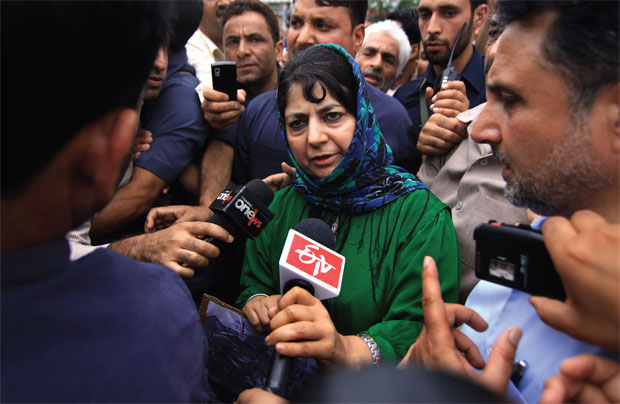The challenge for the two parties will be to find a political middle ground where they can lay aside their contentious positions and come together.
Though election results in Jammu and Kashmir have been more or less along the expected lines with PDP and BJP emerging as the first and the second largest party, the National Conference and the Congress have nevertheless retained their political relevance.
The final results for the 87 seats of J&K Assembly have given PDP 28, BJP 25, NC 15 and Congress 12. And Sajjad Lone, the separatist-turned-mainstream politician, who brought some excitement to the campaign in Valley has won two seats.
The election has completely rewritten the political script in the state. Now for the first time since 1947 it is not the National Conference and Congress which will control the destiny of the state. The two have been replaced by PDP, now a vaunted Valley-centric political force, and the BJP, a newly ascendant force in Jammu.
NC, once a monopolistic pan-J&K party is now reduced to a rump in its core constituency in Kashmir Valley. And Congress, which over the past twelve years, had emerged as a kingmaker party without whose support neither NC, nor PDP could form the government has lost this invincible position. And BJP has stepped into the breach.
BJP’s entry into the picture has brought its own set of problems in its train: it has created a deep ideological quandary for the PDP which is certain to lead the new state government. Any alliance between PDP and BJP will have to first get over or get out of the way some fundamental sticking points like Article 370, AFSPA or for that matter PDP’s own soft-separatist stand on the resolution of Kashmir issue.
But despite that PDP-BJP coalition is the only best possible political scenario for the state. With BJP almost sweeping the Hindu majority Jammu, a new state government can only leave it out at its own peril. For, this will not only keep an entire region out of its share in political power, a trigger for a destabilizing regional discord, but also a resurgent BJP backed by its own majority government at the centre. More so, when the existing political trends in the country point to BJP getting only stronger by the day and becoming more influential on the national scene.
PDP could also go with Congress, an ally from the party’s previous stint in power from 2002-08. But a PDP-Congress apart from its abstract logic of both being secularist in their outlook would hardly be in a better position to deliver. Congress, despite also being a Jammu-centric party in the state, will still not be adequately representative of the province.
Besides, there are sufficient warnings from the past to dissuade PDP from such an option. For such a scenario would be a throwback to the fateful 1983 polls with NC winning 46 seats, a predominant number of them from Kashmir Valley and the Congress winning 26, all but two of them in Jammu. While NC formed the government with Dr Farooq Abdullah as the Chief Minister, Jammu felt left out, breeding a bitter regional tussle which didn’t allow the state government to function. The government lasted thirteen months when it succumbed to a split in NC reportedly engineered by New Delhi. A new government was formed by Farooq’s brother-in-law Ghulam Mohammad Shah with outside support from Congress which also ruled at the centre with Indira Gandhi as the prime minister.
It is for the same reason that a PDP-NC alliance, albeit unthinkable, is not possible, although Omar Abdullah has, in an apparently tactical move, offered to consider support to PDP if the party approaches him. Both are pre-eminently Valley-based parties and their alliance will again be interpreted as the political domination of the Valley over Jammu and Ladakh, which in turn will keep them at loggerheads with the state government.
But given the fractured mandate that the elections have thrown up, there are apparently more theoretical possibilities for the government formation, without necessarily involving PDP, the largest single party. That is, should NC and BJP join hands with the support of some independents. Chief Minister Omar Abdullah has already alluded to such a possibility in th election campaign. But such an arrangement, though possible, would again be a negation of the political mandate in the state.
The situation is likely to become clear in the coming days as the PDP and BJP get down to working out their options. But considering the signals that are emerging from the PDP headquarters, the party seems more inclined towards an alliance with BJP. The challenge for the two parties will be to find a political middle ground where they can lay aside their contentious positions and come together for the government formation.
But even when all the political differences would be resolved, the talks could still come down to the power-sharing arrangement between the two parties. What if BJP demands a rotational Chief Minister on the pattern of PDP-Congress coalition through 2002-08? Shall PDP agree to it? It is likely that PDP will. With the two parties almost splitting the state between them, PDP will have no option but to fall in line with such an arrangement. Should that happen BJP could for the first time be able to install a Hindu CM in a Muslim majority state, a move that would be of tremendous psychological boost to its constituency in Jammu. Besides, one could also expect a running tussle over the regional share of resources, a discourse that thrives in all the three regions of the state.
This divergence of interests coupled with recurrent ideological tension bodes ill for the prospect of a stable and sustainable new J&K government. Unlike the three governments in the last eighteen years which completed their term, despite the latter two being the coalitions, the new J&K government, which would again be a coalition, may find the road too bumpy to stay on course.

